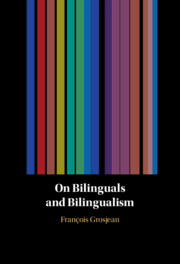Book contents
- On Bilinguals and Bilingualism
- On Bilinguals and Bilingualism
- Copyright page
- Dedication
- Contents
- Figures
- Tables
- Introduction
- 1 The Setting
- 2 A Holistic View of Bilingualism
- 3 The Bilingual’s Language Modes
- 4 The Complementarity Principle
- 5 Spoken Language Processing
- 6 Cross-linguistic Influence
- 7 Bilinguals Who Are Also Bicultural
- 8 The Bilingualism and Biculturalism of the Deaf
- 9 The Statistics of Bilingualism
- 10 Special Bilinguals
- 11 A Bilingualism Researcher’s Social Role
- Appendix The Right of the Deaf Child to Grow Up Bilingual
- References
- Index
6 - Cross-linguistic Influence
Published online by Cambridge University Press: 08 February 2024
- On Bilinguals and Bilingualism
- On Bilinguals and Bilingualism
- Copyright page
- Dedication
- Contents
- Figures
- Tables
- Introduction
- 1 The Setting
- 2 A Holistic View of Bilingualism
- 3 The Bilingual’s Language Modes
- 4 The Complementarity Principle
- 5 Spoken Language Processing
- 6 Cross-linguistic Influence
- 7 Bilinguals Who Are Also Bicultural
- 8 The Bilingualism and Biculturalism of the Deaf
- 9 The Statistics of Bilingualism
- 10 Special Bilinguals
- 11 A Bilingualism Researcher’s Social Role
- Appendix The Right of the Deaf Child to Grow Up Bilingual
- References
- Index
Summary
The influence of one language on the other when bilinguals speak and write monolingually is an intriguing phenomenon. The author first revisits how interference has been defined over the years by major researchers. He then argues that the definitions proposed were simply too broad, and covered not only interferences but also other contact phenomena such as code-switches and borrowings. The only way to get to the bottom of this problem is to control the language mode bilinguals and language learners are in when they are being observed. In addition, he suggests that we differentiate permanent traces of one language on the other (to be called transfers) from ephemeral intrusions of the other language (these would be interferences). The author continues by describing research conducted with his colleagues on Spanish–French bilinguals in the French-speaking part of Switzerland. The results obtained allowed them to have a better understanding of language restructuring in a first language. In addition, and as a by-product, it gave them a way to differentiate ephemeral intrusions from more permanent traces of the other language. He ends the chapter with a few words on bilinguals’ comprehension of speech containing cross-linguistic influences that comprise both transfers and interferences.
Keywords
- Type
- Chapter
- Information
- On Bilinguals and Bilingualism , pp. 93 - 102Publisher: Cambridge University PressPrint publication year: 2024



